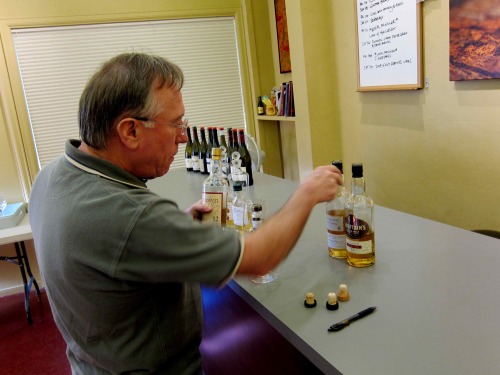Staff Education - Blending

Every Tuesday is staff development day where one of our regional buyers opens about 20-30 wines from their selection and traverses between both SF and RWC stores to give us some education. I lobbied to be on this list for 2011 but, alas, there are too many K&L employees who do not drink spirits to justify giving me one of those spots. They did give me permission to hold impromptu training events whenever I felt it necessary, so I decided to take my lovely Sunday crew for a little blending action.
After talking to John Glaser about starting with experimental vatting in his London apartment's kitchen, I was inspired to try something like that here. There's obviously no point in vatting whiskies that have already been vatted, so I would have to find some bottles that were from single barrels, and if they could be cask strength, even better. Here's what I went with:

The Auchentoshan 18 would make a great base. Light, fruity, high proof at 56.9% and interesting. I wanted some peat so we chose the Ellenstown 12, which I understand to be a single batch of Ardbeg, also coming in at cask strength 57%. To add some oily richness we took the fantastic Glencadam 22, while at only 43%, should help to proof it down a bit as well. You can tell I was looking for something similar to the Flaming Heart with these ingredients.
To help prepare the staff for what the blends could possibly taste like, I had created a few on my own in advance and had given them a week to settle down and integrate. The staff's job was to taste the three ingredients on their own, then taste my sample blends, and attempt to create their own blend into the empty glass bottles that I provided them. We would then taste each blend after a week to see how successful they were in creating their own expression.

The blends I had created were as follows: Batch 1 - 25% Auchentoshan, 50% Ardbeg, 25% Glencadam. Batch 2 - 33% of each. Batch 3 - 50% Ardbeg, 50% Glencadam. The flavors of all three blends were interesting, but #2 was easily the most balanced and drinkable. Equal amounts of each really went a long way in balancing the flavors out.

While we didn't have enough time to taste everyone's blend yesterday, I was present to watch our Australian/NZ wine buyer Jimmy C in action. He has had some experience with wine blending in Australia and he took his craft very seriously - really measuring things out and getting intricate with the meshing of flavor profiles. His final batch was something like 50% Glencadam, 30% Ardbeg, 20% Auchentoshan and it smelled amazing. I can't wait to go back and try it today.
The point of this article? Blending is a fun exercise in understanding how single malts are structured. When the master blenders are putting together a new batch of Talisker 10, how many different batches of Talisker are they using from different ages and different flavors, I wonder? You can play blender in your own kitchen by doing the same experiment. Get some friends to pitch in some cash, buy some single barrel cask strength expressions, and get creative.
-David Driscoll
